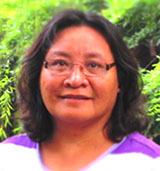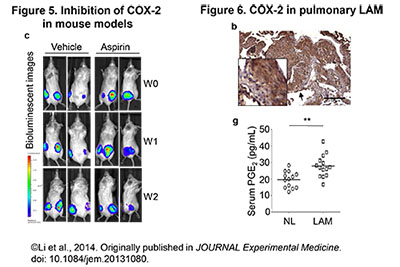Posted March 18, 2014
Jane Yu, Ph.D., Brigham and Women's Hospital, Boston, Massachusetts
 Lymphangioleiomyomatosis (LAM) is a rare lung disease that leads to lung destruction and respiratory failure, primarily in women. LAM cells are histologically benign smooth muscle cells carrying Tuberous Sclerosis Complex 2 (TSC2) gene mutations that are believed to metastasize to the lungs. Many end-stage LAM patients may require lung transplantation; however, the tumors may return in the transplanted lungs after a year. In LAM patients the mammalian target of rapamycin complex 1 (mTORC1) inhibitor rapamycin stabilizes lung function and improves symptoms, but not all patients respond to this therapy and lung function declines when rapamycin is discontinued. Dr. Jane Yu, at Brigham and Women's Hospital, is investigating the role of estrogen in the pathogenesis of LAM. She has observed that the female hormone, 17-beta estradiol (E2), promotes the survival and lung metastasis of TSC2-null cells as well as increased levels of prostaglandin production, including PGE2, in these tumors.
Lymphangioleiomyomatosis (LAM) is a rare lung disease that leads to lung destruction and respiratory failure, primarily in women. LAM cells are histologically benign smooth muscle cells carrying Tuberous Sclerosis Complex 2 (TSC2) gene mutations that are believed to metastasize to the lungs. Many end-stage LAM patients may require lung transplantation; however, the tumors may return in the transplanted lungs after a year. In LAM patients the mammalian target of rapamycin complex 1 (mTORC1) inhibitor rapamycin stabilizes lung function and improves symptoms, but not all patients respond to this therapy and lung function declines when rapamycin is discontinued. Dr. Jane Yu, at Brigham and Women's Hospital, is investigating the role of estrogen in the pathogenesis of LAM. She has observed that the female hormone, 17-beta estradiol (E2), promotes the survival and lung metastasis of TSC2-null cells as well as increased levels of prostaglandin production, including PGE2, in these tumors.
With funding from a Fiscal Year 2011 Exploration - Hypothesis Development Award, Dr. Yu is testing her hypothesis that E2 induces cyclooxygenase-2 (COX-2) activity, the rate-limiting enzyme in the biosynthesis of prostaglandins. She believes that these elevated COX-2 levels will result in increased prostaglandin biosynthesis, which, in turn, will promote the survival and lung metastasis of TSC2-null cells. A corollary of this hypothesis is that COX-2 suppression will block E2-promoted lung metastasis and will induce regression of lung lesions.
Dr. Yu and her research team, in collaboration with Drs. Kwiatkowski, Levy, Henske, Xu and Blenis, found that, in TSC2-null cells, E2 increases COX-2 activity and enhances prostaglandin production in an mTORC1-independent way. Treatment of TSC2-null cells with aspirin, a COX-2 inhibitor, resulted in decreased PGE2 production and decreased cell proliferation. Moreover, aspirin treatment of a TSC2 xenograft model resulted in decreased tumor size, decreased levels of COX-2 in the tumors, and decreased urinary PGE2 levels. Furthermore, COX-2 was abundant in LAM lesions, and PGE2 serum levels were elevated in LAM patients.
Dr. Yu and her team believe that aspirin and/or other COX-1/COX-2 inhibitors may be effective in slowing the clinical progression of LAM. It is worth noting that aspirin and other COX-1/COX-2 inhibitors' side effects and toxicity profiles are well characterized, making them promising candidates for long-term LAM therapy.

Publication:
Li C, Lee P-S, Sun Y, et al. 2014. Estradiol and mTORC2 cooperate to enhance prostaglandin biosynthesis and tumorigenesis in TSC2-deficient LAM cells. J Exp Med 211(1):15-28.
Links:














